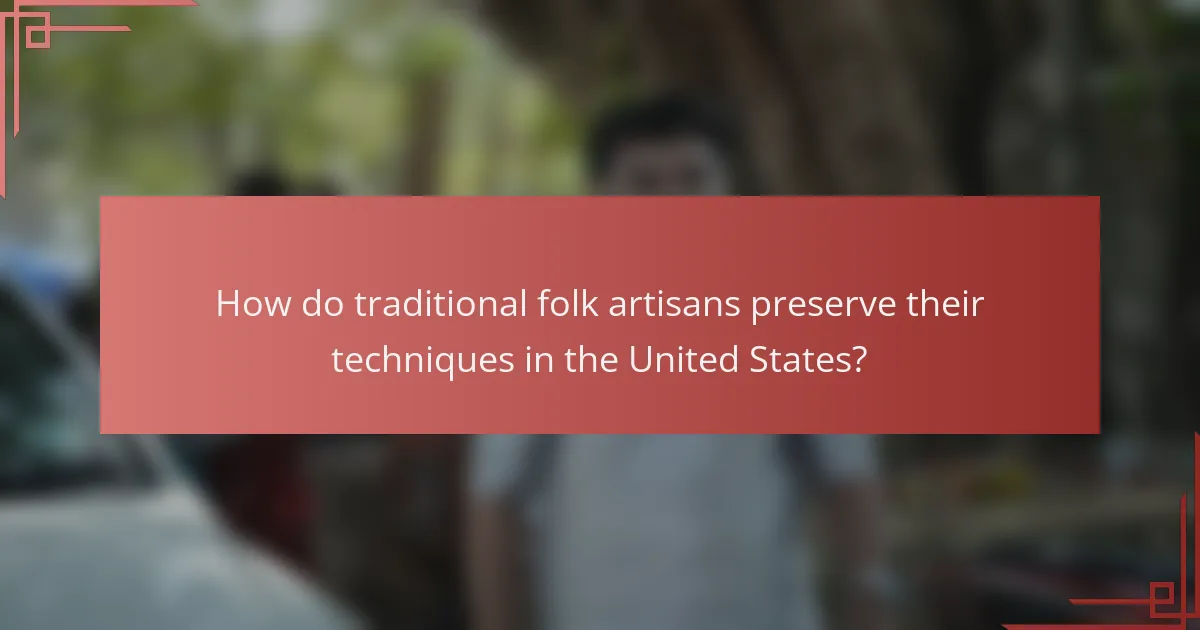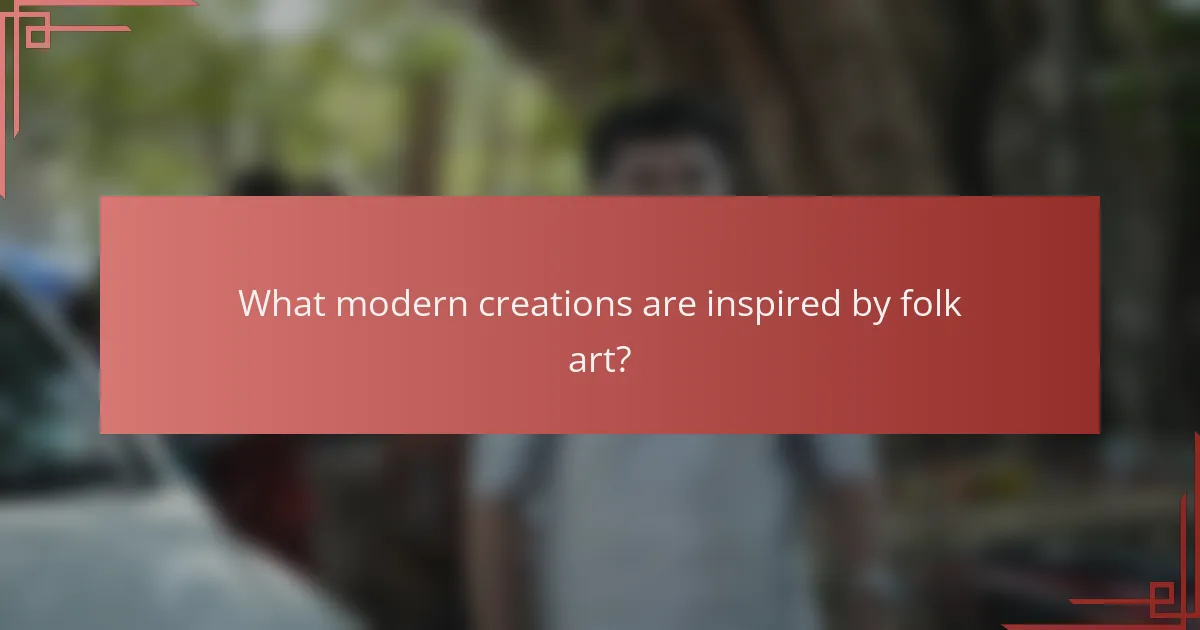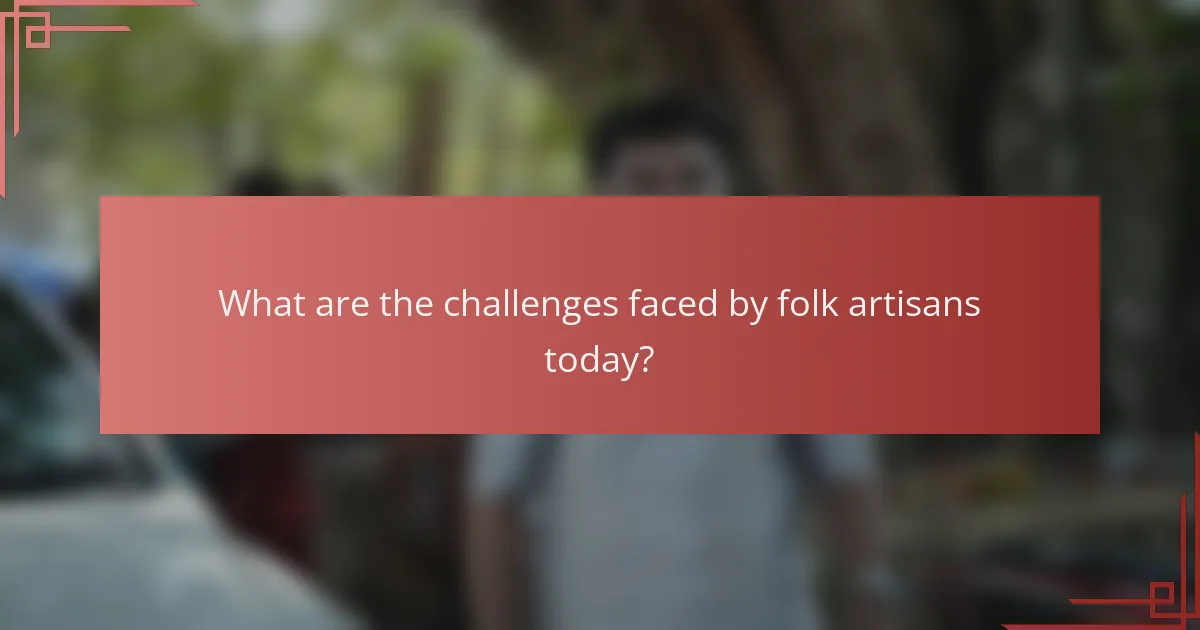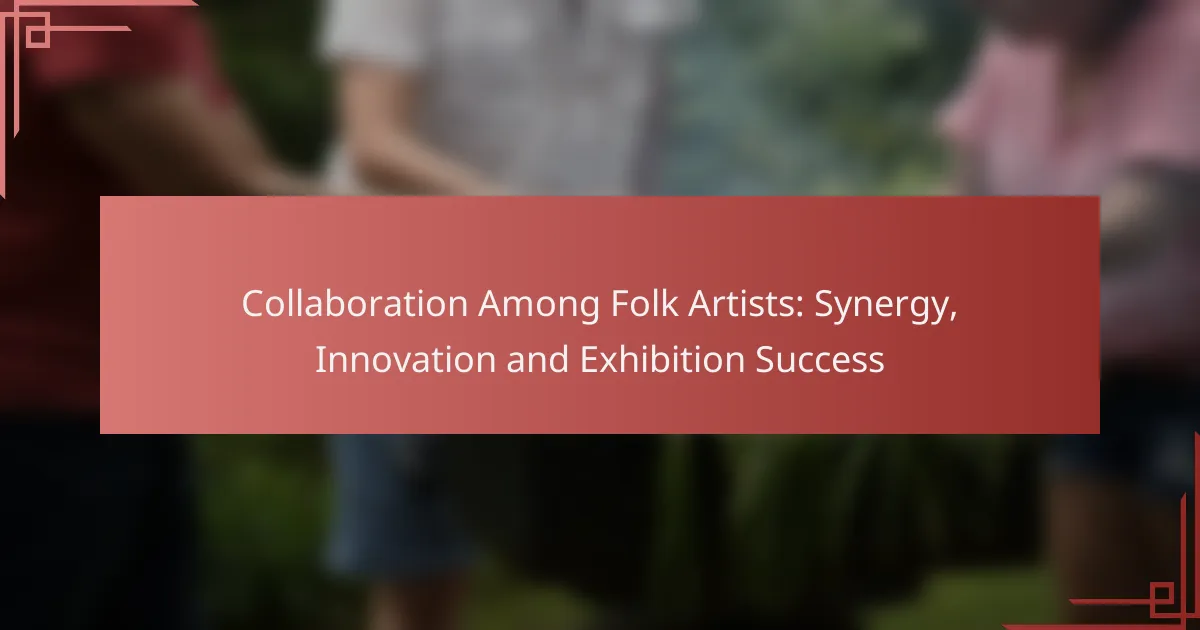Folk artisans in the United States play a vital role in preserving traditional techniques through hands-on practice and cultural storytelling, ensuring that their crafts remain authentic and significant. Modern interpretations of folk art merge these age-old methods with contemporary aesthetics, resulting in unique creations that celebrate cultural heritage. This art form not only reflects the rich history and craftsmanship of its creators but also serves as a visual representation of the traditions and identities of diverse communities across North America.

How do traditional folk artisans preserve their techniques in the United States?
Traditional folk artisans in the United States preserve their techniques through a combination of hands-on practice, community engagement, and cultural storytelling. These methods ensure that skills and knowledge are passed down through generations, maintaining the authenticity and significance of their crafts.
Use of natural materials
Folk artisans often rely on natural materials sourced from their local environments, such as wood, clay, and fibers. This choice not only reflects their cultural heritage but also promotes sustainability by minimizing reliance on synthetic products. For example, basket weavers may use reeds or grasses found in nearby wetlands, while pottery makers often utilize local clay types.
Using natural materials can enhance the uniqueness of each piece, as variations in texture and color are inherent to the raw materials. Artisans must be knowledgeable about the properties of these materials to ensure durability and functionality in their creations.
Community workshops
Community workshops play a crucial role in the preservation of traditional folk art techniques. These gatherings provide a space for artisans to share their skills with others, fostering a sense of belonging and collaboration. Participants can learn directly from experienced artisans, gaining hands-on experience and insights into traditional methods.
Workshops can vary in size and frequency, ranging from small, informal gatherings to larger organized events. They often include demonstrations, group projects, and opportunities for participants to create their own works, reinforcing the communal aspect of folk art.
Storytelling traditions
Storytelling is an integral part of folk art, as it conveys the cultural significance and history behind various techniques. Artisans often share stories related to their crafts, including the origins of specific designs or the meanings behind certain symbols. This narrative aspect enriches the viewer’s understanding and appreciation of the artwork.
Incorporating storytelling into their practice helps artisans connect with their audience on a deeper level. It also serves as a means of preserving cultural heritage, ensuring that the stories and traditions associated with their crafts are not lost over time.

What modern creations are inspired by folk art?
Modern creations inspired by folk art often blend traditional techniques with contemporary aesthetics, resulting in unique designs that celebrate cultural heritage. These creations can be found in various forms, including textiles, furniture, and decorative items, reflecting the rich history and craftsmanship of folk artisans.
Contemporary textile designs
Contemporary textile designs frequently draw from folk art traditions, utilizing patterns, colors, and techniques that have been passed down through generations. Designers may incorporate hand-weaving, embroidery, or dyeing methods to create fabrics that tell a story or evoke a sense of place.
For example, textiles inspired by Native American patterns or Scandinavian folk motifs are popular in modern home decor. When selecting fabrics, consider the balance between traditional craftsmanship and modern functionality to ensure the designs fit well in contemporary settings.
Furniture with traditional motifs
Furniture that features traditional motifs often showcases intricate carvings, vibrant colors, and unique shapes that reflect cultural stories. Many artisans create pieces that honor their heritage while meeting modern design standards, resulting in functional art that enhances living spaces.
When choosing furniture inspired by folk art, look for items that use sustainable materials and craftsmanship techniques. This not only supports local artisans but also ensures that the pieces are durable and environmentally friendly. Popular examples include hand-painted cabinets or chairs with folk-inspired upholstery, which can serve as statement pieces in any room.

What is the cultural significance of folk art in North America?
Folk art in North America holds immense cultural significance as it embodies the traditions, stories, and identities of various communities. It serves as a visual representation of heritage, connecting generations while promoting local craftsmanship and economies.
Representation of heritage
Folk art acts as a vital link to the past, showcasing the unique customs and narratives of different cultural groups. Through mediums such as pottery, textiles, and woodwork, artisans express their heritage, often incorporating symbols and techniques passed down through generations.
For instance, Native American beadwork not only reflects artistic skill but also tells stories of tribal history and identity. Each piece can convey specific meanings, making folk art a powerful tool for preserving and celebrating cultural heritage.
Promotion of local economies
Folk art significantly contributes to local economies by supporting artisans and small businesses. By purchasing handmade items, consumers help sustain traditional crafts and provide livelihoods for artists within their communities.
Art fairs and markets often feature local artisans, creating opportunities for direct sales and community engagement. This not only boosts local economies but also fosters a sense of pride and connection among residents, enhancing the cultural landscape of the area.

How can folk artisans leverage digital platforms for visibility?
Folk artisans can significantly enhance their visibility by utilizing digital platforms, which offer a broad audience reach and various tools for engagement. By effectively showcasing their unique crafts online, artisans can connect with potential customers and build a loyal following.
Social media marketing
Social media marketing allows folk artisans to share their work, tell their stories, and engage with their audience in real time. Platforms like Instagram and Facebook are particularly effective for visual content, enabling artisans to post images and videos of their creations, behind-the-scenes processes, and customer testimonials.
To maximize impact, artisans should focus on creating consistent, high-quality content that reflects their brand identity. Engaging with followers through comments, polls, and live sessions can also foster a sense of community and encourage word-of-mouth promotion.
Online marketplaces like Etsy
Online marketplaces such as Etsy provide a dedicated platform for artisans to sell their crafts directly to consumers. These platforms are designed to attract buyers interested in unique, handmade items, making them ideal for folk artisans looking to reach niche markets.
When setting up a shop, artisans should ensure their listings are optimized with clear descriptions, high-quality images, and competitive pricing. Regularly updating inventory and utilizing promotional tools offered by the marketplace can further enhance visibility and sales potential.

What are the challenges faced by folk artisans today?
Folk artisans today encounter several significant challenges, including competition from mass production and the need to preserve their cultural authenticity. These issues can impact their ability to sustain traditional practices while adapting to modern market demands.
Competition from mass production
Folk artisans face intense competition from mass-produced goods, which are often cheaper and more widely available. This competition can undermine the market for handcrafted items, making it difficult for artisans to sell their work at fair prices.
To combat this, artisans can emphasize the unique qualities of their creations, such as craftsmanship, cultural significance, and the use of traditional techniques. Building a strong brand identity and engaging with local communities can also help artisans differentiate their products.
Preserving authenticity
Maintaining authenticity is crucial for folk artisans, as it connects their work to cultural heritage and tradition. However, the pressure to adapt to modern trends can lead some artisans to alter their techniques or designs, risking the loss of cultural significance.
Artisans should strive to balance innovation with tradition by incorporating contemporary elements while honoring their roots. Participating in workshops, cultural exchanges, and local festivals can also help artisans stay connected to their heritage and promote authentic practices.

How do folk art festivals contribute to artisan communities?
Folk art festivals play a crucial role in supporting artisan communities by providing a platform for exposure, sales, and cultural exchange. These events foster connections among artisans, consumers, and cultural enthusiasts, enhancing the visibility and viability of traditional crafts.
Networking opportunities
Folk art festivals create valuable networking opportunities for artisans, allowing them to meet peers, suppliers, and potential buyers. These connections can lead to collaborations, mentorship, and partnerships that strengthen the artisan community.
Attending these festivals can also help artisans learn from each other’s techniques and business practices, fostering a spirit of cooperation and innovation. For example, a potter might share glazing techniques with a fellow artisan, enhancing the quality of their crafts.
Showcasing traditional crafts
These festivals serve as a showcase for traditional crafts, allowing artisans to display their work to a broader audience. This visibility can lead to increased sales and greater appreciation for cultural heritage, as attendees often seek unique, handcrafted items.
Artisans can also use these events to educate the public about the significance of their crafts, sharing stories and techniques that highlight their cultural roots. This not only preserves traditional methods but also encourages a new generation to engage with folk art.



